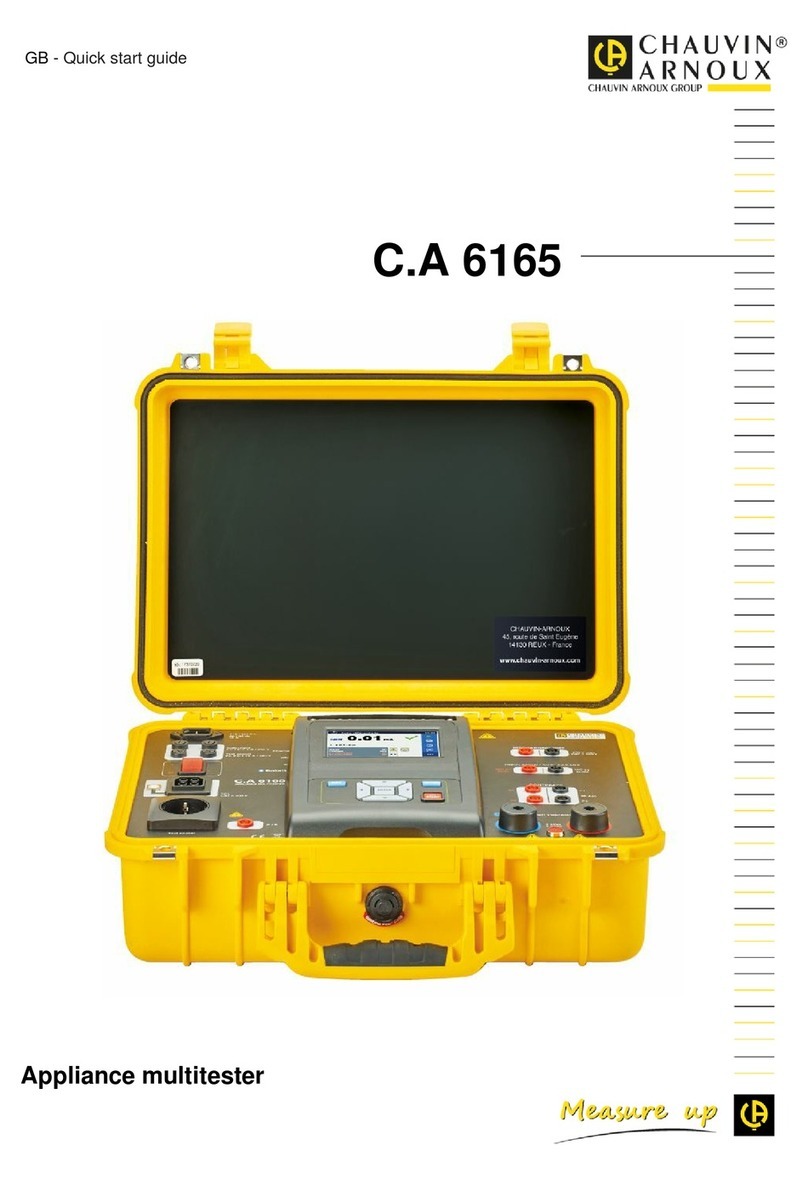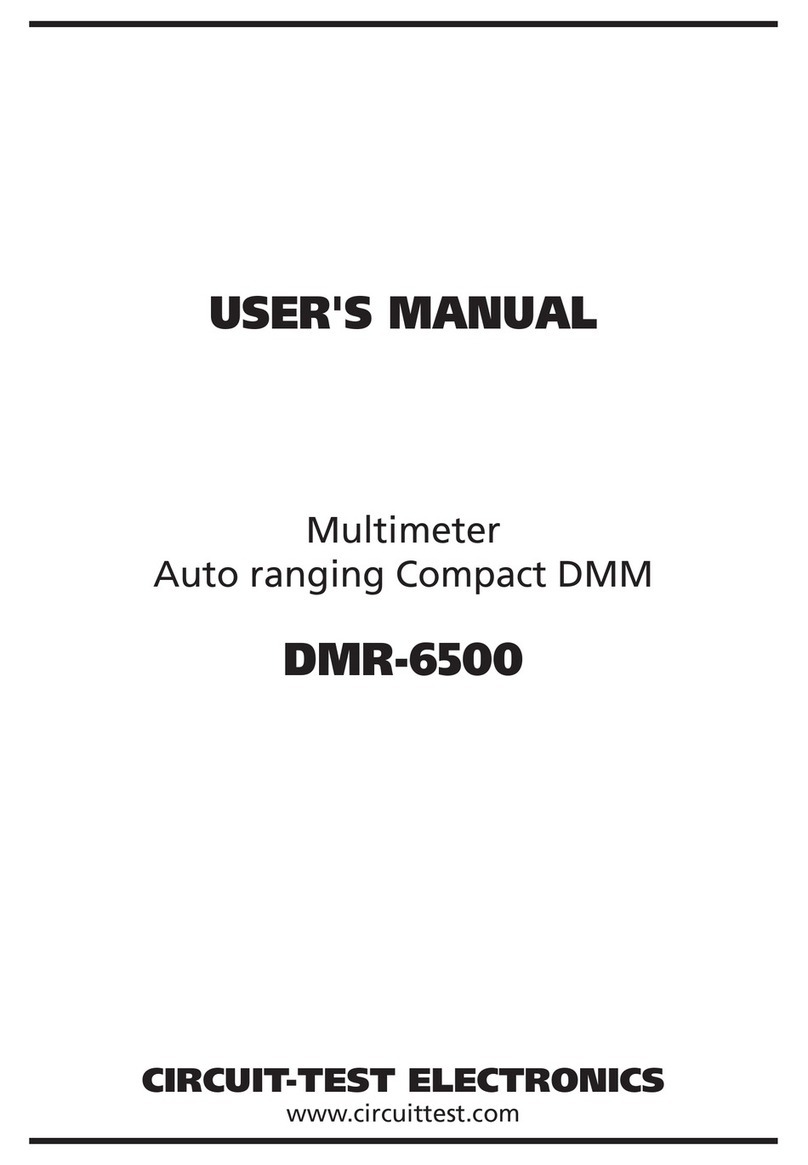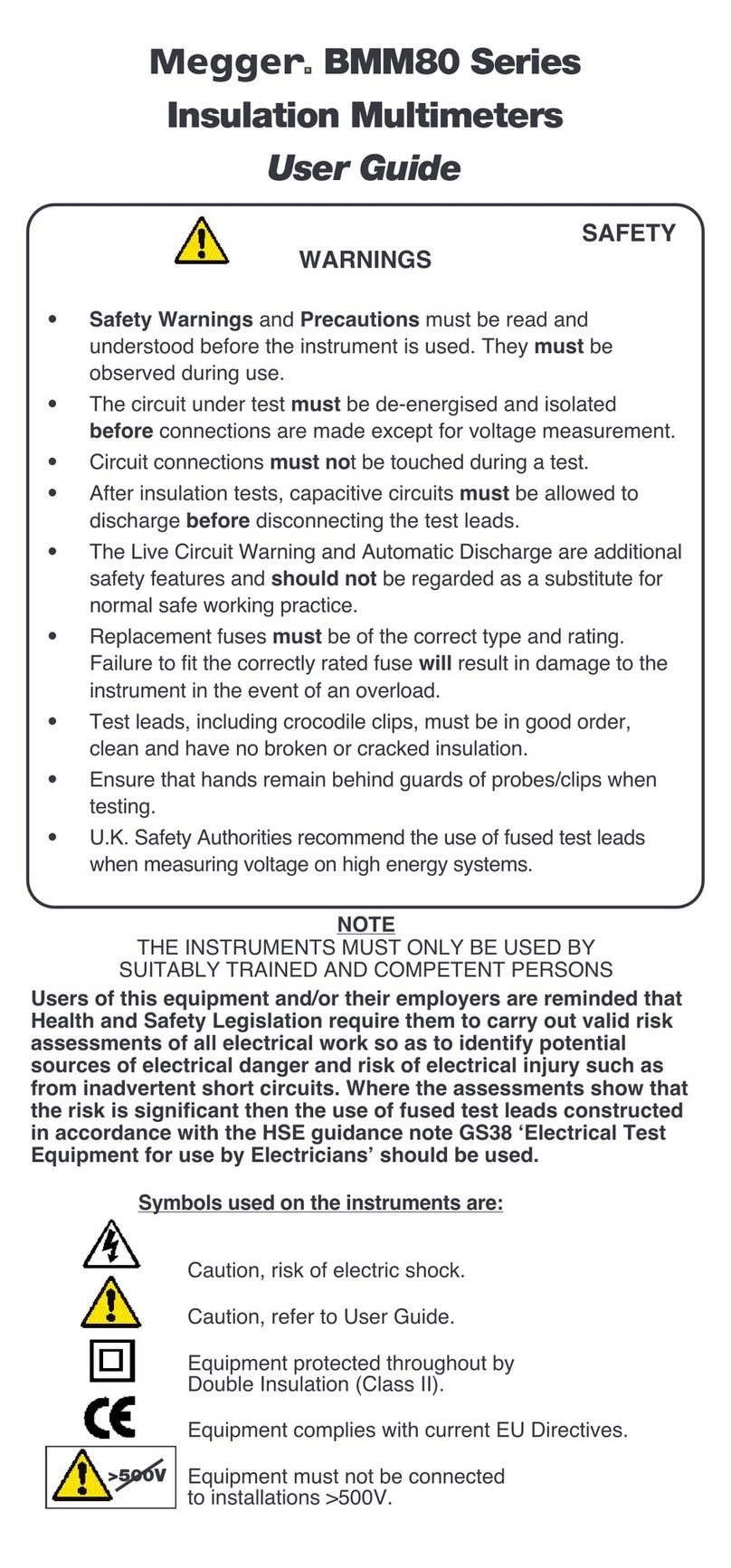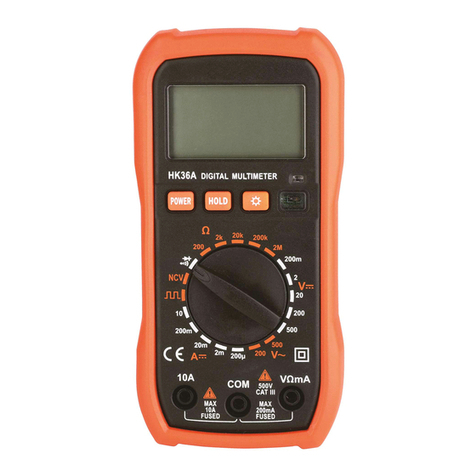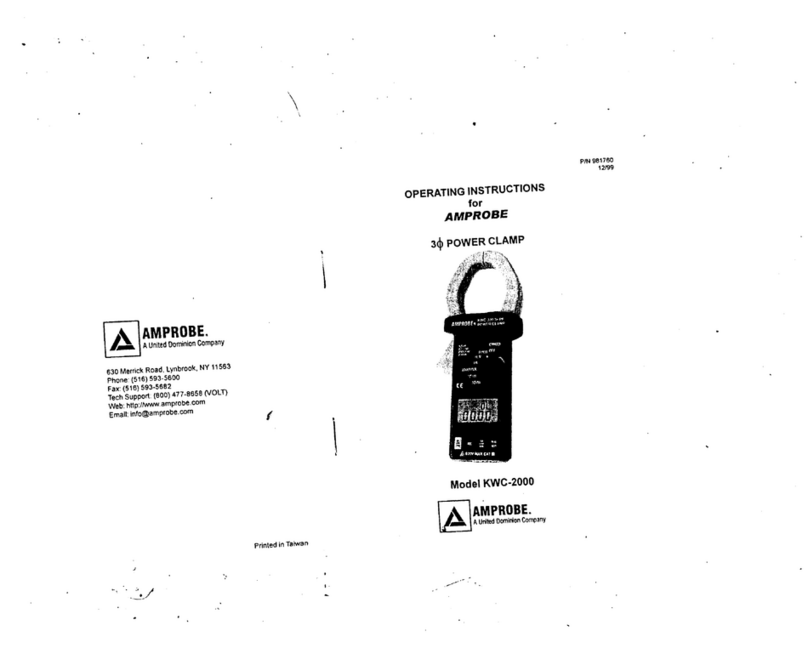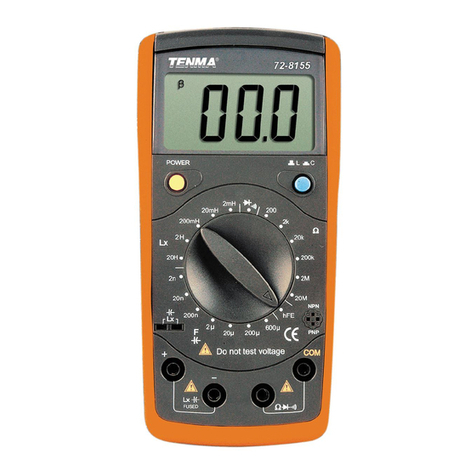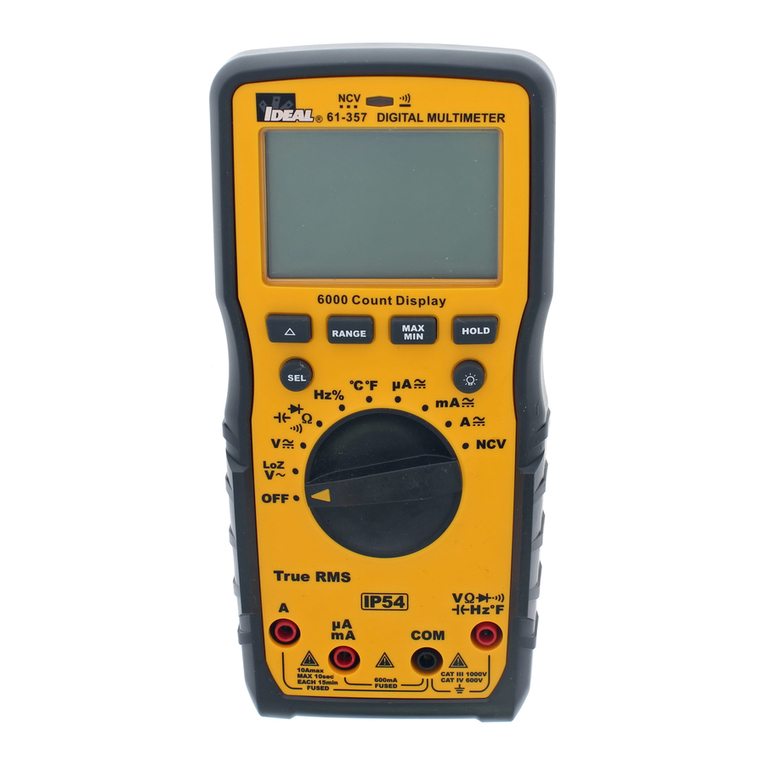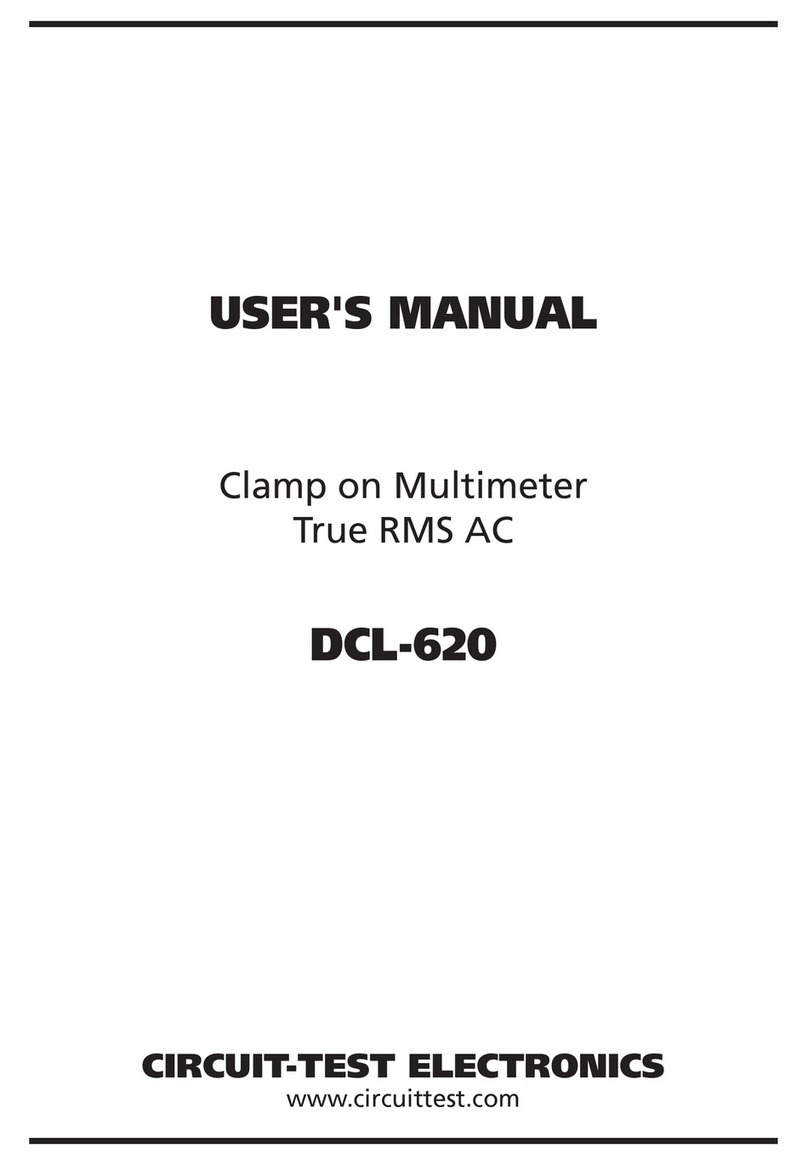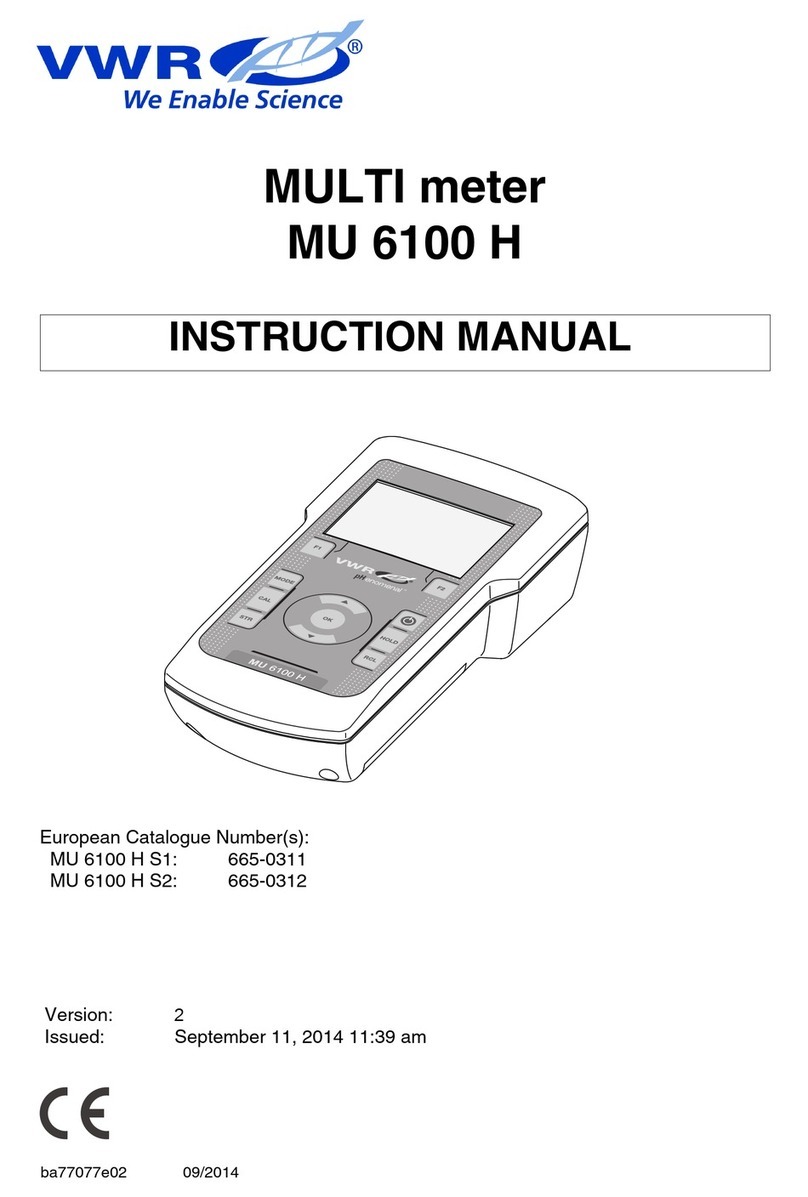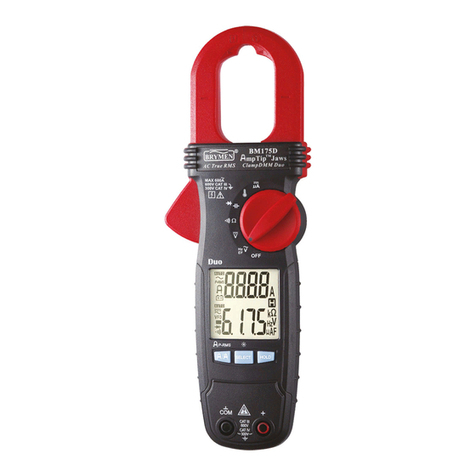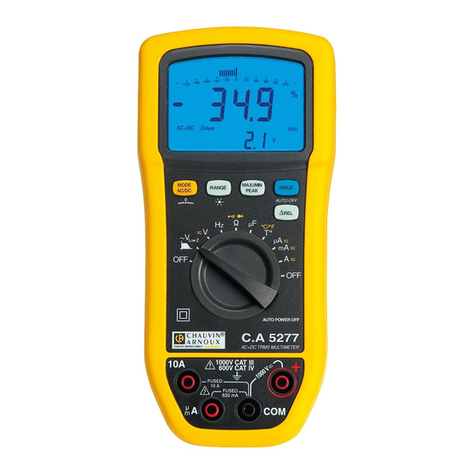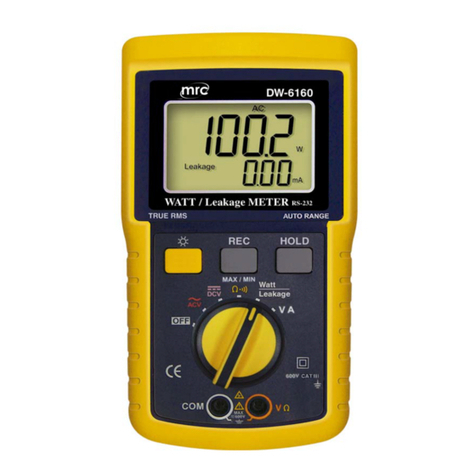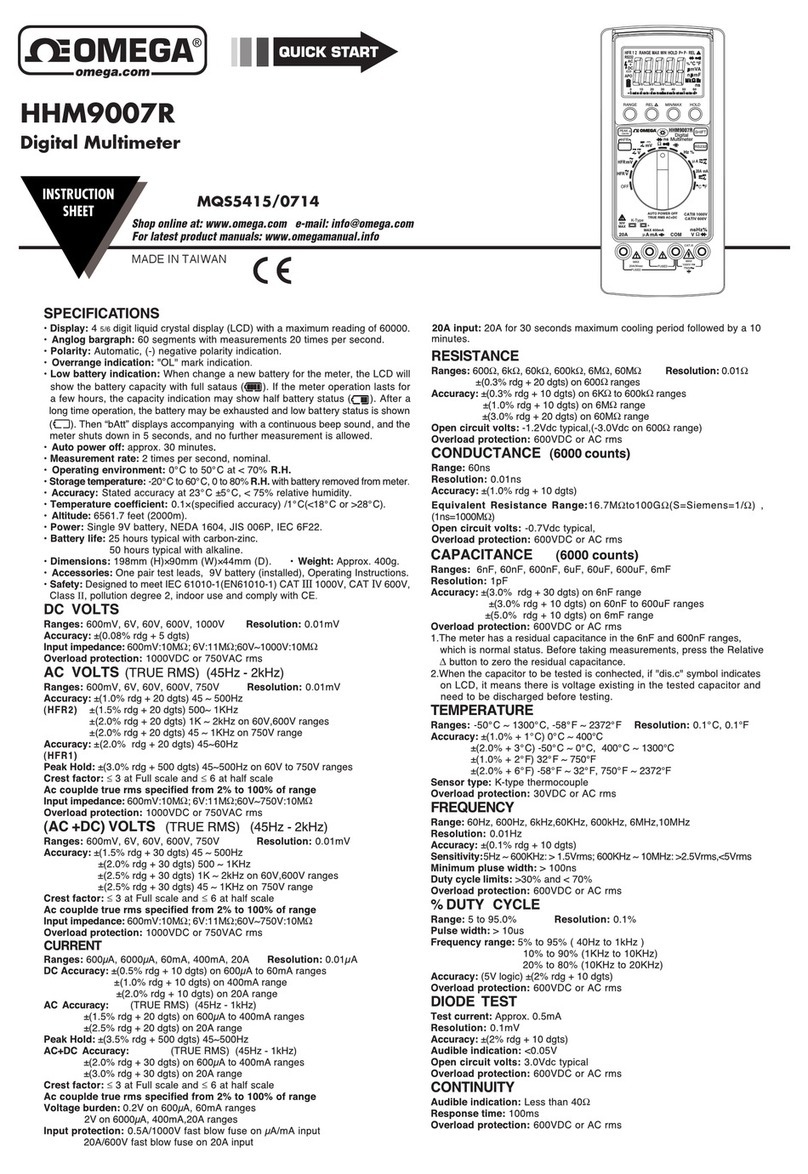Chauvin Arnox F 05 User manual

■■
■■
■Pince multimètre
■■
■■
■Clamp multimeter
■■
■■
■Vielfachmesszange
■■
■■
■Pinza multimetro
■■
■■
■Pinza multimétrica
F 05
FRANÇAIS
ENGLISH
DEUTSCH
ITALIANO
ESPANOL
Notice de fonctionnement
User's manual
Bedienungsanleitung
Libretto d’Istruzioni
Manual de Instrucciones

25
English
Meaning of symbol
Caution!PleaseconsulttheUserManualbeforeusingthedevice.
In this User Manual, failure to follow or carry out instructions
preceded by this symbol may result in personal injury or damage
to the device and the installations.
Meaning of symbol
This appliance is protected by double insulation or reinforced
insulation.It does not have to be connected to an earth protection
terminal for electrical safety.
Meaning of CAT III symbol
This voltage surge category III clamp, with pollution level 2,
complies with stringent reliability and availability requirements,
corresponding to fixed industrial and domestic installations (see
IEC 664-1, ed 92).
Thank you for purchasing this “F05”series multimeter clamp.
To get the best service from this instrument:
nread this user’s manual carefully,
nrespect the safety precautions detailed
PRECAUTIONS FOR USE
■Never use on networks with voltage higher than 600V in relation to
the ground and whose overvoltage category is higher than III, i.e.
fixed industrial and domestic installations (see IEC 664-1).
■Indooruseinenvironmentswith a degree of pollution of 2 maximum
(cf. IEC 664-1), temperature of 0°C to + 50°C and relative humidity
lower than 70%.
■Use accessories compliant with safety standards
(NF EN 61010-2-031) with minimal voltageof 600V and overvoltage
category III.
■Never open the clamp box before disconnecting all power sources.
■Never connect to the circuit to be measured if the clamp box is not
properly closed.
■Before any measurement,checktheproperpositioningofthecables
and switch.
■Whenmeasuringcurrent checkforproperalignmentof theconductor
in relation to the markers and proper closing of the jaws.
■Alwaysdisconnect theclampfrom anypowersource beforechanging
thebattery.
■Do not perform resistance tests, continuity tests or semi-conductor
tests on a circuit under power.

26
26
CONTENTS
1. PRESENTATION .................................................................... 27
2. DESCRIPTION ....................................................................... 27
3. IMPLEMENTATION - FUNCTIONAL CHARACTERISTICS ... 30
3.1Reference conditions ...................................................... 30
3.2Voltagemeasurements (V) ............................................. 31
3.3 Audio continuity test ( ) .............................................. 32
3.4Resistancemeasurement (Ω)......................................... 32
3.5 Semi-ConductorTest ( )............................................ 33
3.6 Current measurements (A)......................................... 33
3.7INRUSH function ............................................................ 34
3.8Power measurement (W) ................................................ 35
3.9Power factor calculation (PF) .......................................... 36
3.10 Frequency Measurement (Hz) ...................................... 36
3.11 Phase order indication................................................... 37
3.12 Secondary Functions ..................................................... 38
3.12.1Display lock ....................................................................... 38
3.12.2Preselection of MIN/MAX mode ....................................... 38
3.12.3Automatic compensation for cable resistance .................. 39
3.12.4 Automatic compensation of current measurement zero .. 39
3.12.5Manual selection of AC or DC mode ................................ 39
3.12.6 Selections possible in continuity function ......................... 39
3.12.7 Selection OF INRUSH function ......................................... 39
3.12.83.12.8 Suppression of automatic stop .............................. 39
3.12.9Activation of the V-Live function ........................................ 40
3.12.10 Modification of audio indication threshold in
continuity test .................................................................... 40
3.12.11 Default configuration of the unit ........................................ 40
3.12.12 Date of last calibration carried out on unit ........................ 40
3.12.13 Display of the internal software version ............................ 40
3.12.14 Showing of display segments ............................................ 40
4. GENERAL SPECIFICATIONS................................................ 41
4.1Dimensions and weight .................................................. 41
4.2ClampTighteningCapacity ............................................ 41
4.3Power supply .................................................................. 41
4.4Environmentalparameters ............................................. 41
4.5 Compliance with norms .................................................. 41
4.6Variations in operating range .......................................... 42
4.7Marginaloperatingconditions......................................... 44
5. TO ORDER ............................................................................. 45
6. GUARANTEE ......................................................................... 45
7. MAINTENANCE ..................................................................... 46
7.1Changing the battery ...................................................... 46
7.2Storage........................................................................... 46
7.3Cleaning ......................................................................... 46
7.4Metrologicalverification .................................................. 46
8. APPENDIX ........................................................................... 117
1
2
3

27
1.PRESENTATION
Clamp multimeter F05 emphasises reliability and simplicity
of use to respond to the needs of power professionals:
■A compact unit integrating the current sensor for intensity
measurements without breaking the test circuit
■Outstanding ergonomic features, in particular:
-automatic or manual selection of the type of signal to be
measured, AC or DC,
-automatic selection of measurement calibre,
-programmable audio voltage indication:V-Live,
-“measurement range exceeded” indication,
-Backlighting of the digital display
-auto power off system,
-MIN - MAX – PEAK value recording function,
-correction of deviations in DC measurement (DC zero)
-automatic compensation of measurement cable
resistance (Ωzero).
■Compliance with CEI electrical safety standards and CE
markings
■Lightness and ruggedness for field use
With all new additional features:
■“Inrush” function in particular for measurement of motor
starting currents.
■Phase order indication function using “2-wire” technique -
PFISTERER
Licence
- (instead of 3-wire) capable of
determination through contact only, with no fastidious
connections.
2. DESCRIPTION
(see diagram in § 8 Appendix)
➀➀
➀➀
➀Jaws
➁➁
➁➁
➁6-way rotary switch:
OFF Deactivation of the clamp, activation is ensured by
selection of other functions
VMeasurement of DC and AC voltages (rms value)
Continuity measurement, by use of the yellow
resistance key and semi-conductor test
AMeasurement of DC and AC voltages (rms value)
W~Measurement of active power in one phase and of
power factor
1
2
3
Selection of phase order indicator for 3- phase
system with or without neutral

28
28
➂➂
➂➂
➂Command keys
The keys are capable of 3 types of action:
Short pressure
< 1.3 s, it is valid if the key pressure is detected.
Long pressure
> 1.3 s, this gives access to a measurement or operating
mode. Holding or releasing the key has no effect.
Held pressure
Gives access to a measurement or operating mode and
remainsin thismodeaslongas pressureisheld.Releasing
the key causes return to the previous mode.
■■
■■
■HOLD has 4 different functions
(see description § 3.12)
:
- Display lock
-Preselection of MIN/MAX mode
-Automatic compensation for cable resistance
-Automaticcompensationof currentmeasurementzero
■■
■■
■The yellow key has 5 different functions
(see description § 3.12)
:
-Manual selection of AC/DC mode
-Selection of INRUSH function
-Selection of resistance function (Ω), semi-conductor
test ( ), continuity test ( )
-Power factor calculation
-Phase order indication measurement
(see description
§ 3.11)
■■
■■
■MIN/MAX operates by end-around shift on short
pressure:
MIN/MAX V and A Functions Otherfunctions
1st press PEAK value MAX value
2nd press MAX value MIN value
3rd press MIN value Return to MAX value
4th press Return to PEAK value _
At any time, a long press on the key will quit the MIN/MAX
mode.IftheINRUSHfunctionwasselected(seedescription
§ 3.7), a short pressure will return to MIN/MAX mode.
Note: In MIN/MAX mode, the Automatic stop function of
the unit is unavailable (symbol
P
).
■■
■■
■Hz A short press displays the frequency of the
measured signal, another press switches back to
the previous value. This key is active only for the
AAC, VAC and W functions.
■■
■■
■Short pressure: display backlight command.
Automatic shutdown after 2 minutes.
Held pressure: display of estimated remaining
battery power, expressed in hours (except INRUSH
and phase order functions).

29
HOLD key/ switch combination
(see description § 3.12):
- Suppression of automatic stop function
- Activation of the V-Live function
- Display of the internal software version
Yellow key/ switch combination
(see description § 3.12):
- Modification of audio indication threshold in continuity test
-Default configuration of the unit
MIN/MAX key/ switch combination
(see description § 3.12):
-Date of last calibration performed on unit
➃➃
➃➃
➃Liquid crystal display
The liquid crystal display includes the digital display of the
measured values, the related units and symbols.
Digital display
4 digits, 9999 points, 3 decimal points , + and - signs
(DC and peak measurement).
+ OL
:Positive value range exceedance (> 3999
points)
- OL
:Negative value range exceedance
OL
:Unsigned value range exceedance
- - - -
: Indeterminate value (middle segments)
Symbol display
+
-
Flashing, clamp power limited to
approximately1 hour
Steady, battery drained, clamp operation or
accuracy no longer guaranteed
P
Constant operation (no automatic shutdown)
ON steady when the INRUSH function is
selected
Fixed: Continuity measurement
Flashing: V-Live function selected
HOLD
HOLD Function active

30
30
PEAK ON in V and A in MIN/MAX mode if the
measurement of the peak value is selected
MAX Indicates the display of a maximum value in
MIN/MAX mode
MIN Indicatesthedisplay of aminimumvalueinMIN/
MAX mode
OK Symbolwhich goes onduringthephase rotation
direction detection sequence.
PF Goes on steady, for switch position W, if power
factor display is selected (yellow key)
AC Fixed: measurement in AC manual mode
Flashing: measurementinAC automatic mode
DC Fixed: measurement in DC manual mode
Flashing: measurementinDC automatic mode
:Semi-conductor test on position ΩΩ
ΩΩ
Ω
■■
■■
■The Buzzer
Different tones are emitted according to the function given
to the buzzer :
-Short and medium sound: valid key
-Short and high-pitched sound: prohibited key
-Short and low sound: Quit MIN/MAX mode
-2short and high-pitched beeps: validation of a
configuration parameter
-Short and medium sound every 400 ms: voltage
measuredhigher thanthe unit’sguaranteedsafetyvoltage.
-5short and medium recurring beeps: automatic
deactivation of the instrument
-Short and medium sound:
measured continuity value, lower than programmed
threshold,short-circuit junction during semi-conductor
test.
-Modulatedmedium continuoussound: valuemeasured
in volts, higher than 45 V peak when the V-Live function
is selected.
3. IMPLEMENTATION
FUNCTIONAL CHARACTERISTICS
3.1 Reference conditions
The functional characteristics mentioned in each of the
measurement functions are guaranteed in the following
reference ranges:
-Temperature: +23°C ± 3 K
-Humidity: 45% to 75% relative humidity
-Supply voltage: 8.5 V ± 0.5 V
-Frequency range of applied AC signal: 45 -65 Hz

31
-Peak factor of applied AC signal: √2
-Position of conductor in clamp jaws: centred.
- Conductor diameter: ≤5 mm
- No external AC magnetic field
- No electrical field
3.2Voltage measurements (V)
1. Connect the measurement leads to the instrument’s
terminals, complying with the polarities indicated: red lead
on the “+” terminal and black lead on the“COM” terminal.
2. Set the rotary switch to position "V".
3. Connect the assembly to the voltage source to be
measured, making sure if possible that this voltage does
not exceed the maximum acceptable limits (see table
below).
Range switching and AC/DC selection are automatic.
Actuate the yellow key to force AC/DC selection manually
if necessary.
If the signal measured is > 45 V peak, the audio indication
is activated if the V-Live function is selected
(see § 3.12.9)
.
Display range 40 V 400 V 4000 V
(1)
Measuring range
(2)
0.2V to 40.0 V to 400 to 600 V
39.99V 399.9V 400 to 900Vpeak
Accuracy 1% R +5 pt 1% R +2 pt 1% R +2 pt
Resolution 10 mV 0.1V 1 V
Inputimpedance 1 MΩ
Protection 600 V AC or DC
(1) In DC, the display indicates +OL
above +600 V and -OL
above -600 V (900 V in PEAK mode).
In AC, the display indicates OL over 600 Vrms (900 V in
PEAK mode).
(2) In AC if the value of the voltage measured is < 0.15V the
display indicates 0.00.
For voltages ≥≥
≥≥
≥600 VDC or rms, a repetitive beep of
the buzzer indicates that the measured voltage is
higher than the unit’s guaranteed safety voltage.
■■
■■
■MIN/ MAX Mode:
-Accuracy: same as previous table +0.2% R
-Capture time: 100 ms typ.
■■
■■
■PEAK Mode:
-Accuracy: same as previous table +2% R
-Capture time: 500 µs typ. (2.5 ms max.)
■■
■■
■Special characteristics in V-Live mode
- Detection threshold accuracy: 45 Vpeak ± 2V

32
32
3.3 Audio continuity test ( )
1. Connect the measurement cables to the unit terminals.
2. Set the rotary switch to position " ".
3. Connect the unit to the circuit to be tested. The buzzer is
continuouslyactiveassoonas contactisestablished(circuit
closed) and if the resistance value measured is lower than
thethresholdvaluechosenby theprogramming (adjustable
from 1 to 40 Ω, see § 03.12.10).
Above 400 Ω, the display indicates
OL
.
■■
■■
■Cable resistance compensation (ΩΩ
ΩΩ
Ωzero)
To measure low resistance values, measure the cable
resistance first.
- Short-circuit the cables.
- Press and hold the HOLD key until zero appears on the
display.Thecableresistancevaluewillthen bememorised
andsubtractedfrom thevalue of theresistancemeasured
later.
Note: If the value measured is higher than 2
Ω
, this
correctionis stopped and the memorised correction
value is reset to zero.
■■
■■
■Characteristics
Display range 400 Ω
Measuringrange 0.0 to 399.9 Ω
Accuracy
(1)
:1% R +2 pt
Resolution 0.1 Ω
Open circuit voltage ≤3.2 V
Measuring current 320 µA
Protection 500 V AC or 750V (DC or peak)
(1)with compensation for measurement cable resistance
■■
■■
■MIN/ MAX Mode:
-Accuracy: same as previous table +0.2% R
-Capture time: 100 ms typ.
3.4Resistance measurements (ΩΩ
ΩΩ
Ω)
1. Connect the measurement cables to the unit terminals.
2. Set the rotary switch to position " " and press once
on the yellow key:The symbol is no longer displayed.
3. Connect the unit to the circuit to be tested.
Range selection is automatic.
To measure low resistance with accuracy, compensate the
cable measurement resistance
(see § 3.3).
Above 40 Ω, the display indicates
OL
.

33
Display range 400 Ω4000 Ω40 kΩ
Measuringrange 0.0 to 400 to 4.00 kΩto
399.9 Ω3999 Ω39.99 kΩ
Accuracy
(1)
:1% R + 2 pt
Resolution 0.1 Ω1 Ω10 Ω
Open circuit voltage ≤3.2 V
Measuring current 320 µA 40 µA
Protection 500 V AC or 750V (DC or peak)
(1)With compensation for measurement cable resistance
■■
■■
■MIN/ MAX Mode:
-Accuracy: same as previous table +0.2% R
-Capture time: 100 ms typ.
3.5 Semi-ConductorTest ( )
1. Connect the measurement leads to the instrument’s
terminals, complying with the polarities indicated: red lead
on the “+” terminal and black lead on the “COM” terminal.
2. Set the rotary switch to " " position and press twice
on the yellow key:The symbol is displayed.
3. Connect the unit to the semi-conductor (junction) to be
tested.
The measurement current moves from the “+” terminals to
the “COM” terminal. It corresponds to the direct testing of
the semi-conductor junction.
-Short-circuit junction: audio indication for a threshold <
0.050 V
-Cut or reversed junction (or threshold > 3.2 V) :
OL
displayed
Display range 4 V
Measuringrange 0 to 3.199V
Accuracy 1% R +2 pt
Resolution 1 mV
Measuring current
(1)
2 mA to 4 mA
Protection 500 V AC or 750V (DC or peak)
(1)Per the voltage measured
■■
■■
■MIN/ MAX Mode:
-Accuracy: same as previous table +0.2% R
-Capture time: 100 ms typ.
3.6 Current measurements (A)
1. Set the rotary switch to position "A "
2. Clamp the conductor carrying the current to be measured,
check for proper closing of the jaws and for foreign bodies
in the gap.
ForDC,the“➭”arrowengravedon thejaws mustbedirected
in the presumed direction of current circulation for the sign
of the displayed value to be significant.

34
34
Range switching and AC/DC selection are automatic.
Actuate the yellow key to force AC/DC selection manually
if necessary.
■■
■■
■Correction of the current measurement zero (DC zero)
To measure the low currents, perform a zero correction
first.
-Press and hold the HOLD key until zero appears on the
display.The corrected value will then be memorised and
subtracted from the value of the current measured later.
Note: this correction is performed only on the DC
component of the zero. If the value measured is higher
than 6
Α
, this correction is stopped and the memorised
correction value is reset to zero.
■■
■■
■Characteristics
Display range 40 A 400 A 4000 A
(1)
Measuring range
(2)
0.20 to 40.0 to 400 to
39.99 A 399.9 A 600 Apeak
Accuracy
(3)
:1.5%R1.5% R + 2 pt
+ 10 pt
Resolution 10 mA 100 mA 1 A
(1) In DC, the display indicates +OL
above +400 A and -OL
above -400 A (600 A in PEAK mode).
In AC, the display indicates OL over 400 Arms (900V in
PEAK mode).
(2)In AC, if the value of the current measured is < 0.15 A,
the display shows 0.00.
(3)With correction of zero in DC
-Repeatabilityofthe measurement afterseveralconsecutive
closings of the clamp: 0.3% typical
■■
■■
■MIN/ MAX Mode:
-Accuracy: same as previous table +0.2% R
-Capture time: 100 ms typ.
■■
■■
■PEAK Mode:
-Accuracy: same as previous table +2% R +0.5 A
-Capture time: 500 µs typ. (2.5 ms max.)
3.7INRUSH function
■■
■■
■Description
This function is used to follow quick changes in the current,
such as a damped sinusoidal quantity, by measuring the
successive rms values calculated on ½, 1, 2½, 5 and 10
periods from the largest rms value computed and updated
on ½ period.
The applications are:
-Measurement of motor start-up currents
-Correct definition of fuses and circuit breakers (signal
amplitude-time relationship)
-Stress on components by current overload

35
The field of application is limited to industrial frequencies
(15 Hz... 70 Hz)
■■
■■
■Implementation
Thisfunctionis accessiblein AC current measurementonly,
after selection of the MIN/MAX mode.
Action Display Comments
Press 0.5 P then the value
the yellow for rms Enter the function
key corresponding
out F
Signalfrequency
< 15 Hz or > 70 Hz
Press on 1P-2,5P-5P-10P-0,5P
HOLD key ↑Consultation of values
then press with each time rms (computed on
successively the rms value of consecutive periods )
the yellow corresponding
key alternately
Shortpressure Return to values Exit from the function
on the MIN, MAX or PEAK return to MIN/MAX mode
MIN/MAX key
■■
■■
■Characteristics
-Accuracy: 5% +0.5 A
-Capture time:10 periods of the signal frequency (200 ms
at 50 Hz)
-Range for use: ≥5 A peak for the first period of the signal
3.8Power measurement (W)
1. Connect the measurement leads to the instrument’s
terminals, complying with the polarities indicated: red lead
on the “+” terminal and black lead on the “COM” terminal.
2. Set the rotary switch to position “W”.
3. Connect the clamp on the system selected for power
measurement, complying with the following instructions:
-Connect the measurement cables for voltage
measurement,redcableon phase,blackcableonneutral.
-Clampthe conductor carryingthe currenttobe measured,
checkfor proper closing of the jawsand forforeign bodies
in the gap.
The “ ➭“ arrow on the jaws, must be directed in the
direction of power circulation from the source to the load.
In which case:
- the “+” sign corresponds to power consumed by the
load.
- the “-” sign corresponds to power supplied by the load.
■■
■■
■Specific reference conditions
PF = 1; I ≥2 A; U ≥10 V

36
36
■■
■■
■Active power measurement characteristics
Display range 4000 W 40 kW 400 kW
Measuring range
(2)
5 to 4.00 kW to 40.0 kW to
3999W 39.99 kW 240.0 kW
(1)
Accuracy
(3)
2% R + 1 pt
Resolution 1 W 10 W 100 W
(
1) the scale is limited to 240 kW in one-phase (600 V x
400 A).Above this value, the display indicates +OL or
-OL depending on the sign of the power.
(2) if the power value is < 5 W or if the voltage or current
values are respectively < 0.15 V or < 0.15 A, 0is
displayed.
(3) The measurement accuracy is affected by an instability
linked to current measurement of approximately 0.1 A.
Example:for a power measurement performed at 10 A, the
instability of the measurement will be 0.1 A/10 A, or 1%.
■■
■■
■MIN/ MAX Mode:
-Accuracy: same as previous table +0.3% R
-Capture time: 100 ms typ. (every 400 ms)
3.9Power factor calculation (PF)
With the clamp configured in power measurement (switch on
position W) and correctly connected (see § 3.8), perform a
short press on the yellow key: the power factor is displayed.
Thepowerfactoris,by definition,an unsigned
quantity
,however,
a sign is displayed showing whether the charge is inductive
(“+” sign) or capacitive (“-” sign). This sign is significant only
in the case of slightly distorted signals (i.e.3 switches to zero
over 1 period).
■■
■■
■Characteristics
Display range 1.00
Measuring range
(1)
0.20 to 0.50 to
0.49 1.00
Accuracy 5% R 2% R
+ 2 pt + 2 pt
Resolution 0.01
(1)
The display of the power factor is limited to 1.00
If one of the terms of the power factor calculation is
outside its power range, the display of the power factor
indicates an indeterminate value”- - - -”.
■■
■■
■MIN/ MAX Mode:
-Accuracy: Same for the table below + 1 pt
-Capture time: 100 ms typ. (every 400 ms)
3.10 Frequency Measurement (Hz)
This function is active for measurements V, A, W in AC.
For the power function, the frequency measurement is
performed on the voltage signal.

37
1. Perform a short pressing on the Hz key, the display shows
the frequency of the measured signal.
2. Pressing again returns to the previously displayed
measurement.
■■
■■
■Characteristics
Display range 40 Hz 400 Hz 4000 Hz 40 kHz
Measuring range
(1)
10.00 to 40.0 to 400 to 4.00kHz to
39.99 Hz 399.9 Hz 3999Hz 19.99 kHz
Accuracy 0.4% R +1 ct
Resolution 0.01 Hz 0.1 Hz 1 Hz 10 Hz
Triggeringthreshold
(2)
5 V or 10 A
(1) Below 5 Hz, the display shows 0.0
(2) Below the triggering threshold, the display shows an
indeterminate value (- - - -).
■■
■■
■MIN/MAX
-Accuracy: same as in the table above +0.2% of reading
with limitation to 5 kHz.
-Capture time: 125 ms typ. every 400 ms
3.11 Phase order indication
1
2
3
This measurement is performed with 2 cables only,
sequentially as follows:
1. Integration of a “reference” period on one phase L1-L2 for
example
2. Integration of a “reference” period on one phase L1-L3
3. Calculation of the time delay between “reference” and
“measurement” periods enabling determination of the
phase order or phase rotation direction
■■
■■
■Special reference condition
-3-phase and sinusoidal network with 50 Hz or 60 Hz stable
frequency
■■
■■
■Characteristics
-Frequency range: 47 Hz to 53 Hz or 57 Hz to 63 Hz.
-Acceptable voltage range: 50 V to 600 V
-Acceptable phase imbalance rate: ±10°
-Acceptable amplitude imbalance rate: 20%
-Acceptable voltage harmonic distortion: 10%
■■
■■
■Runningof phase rotationdirection detection sequence
Note 1:
In the following table, display of the symbol " " refers
systematically to the beginning of sequence
Note 2:
The sequence of the following table is described using:
- L1 on terminal “COM”
- L2 then L3 on terminal “+”
The same result is obtained if:
- L2 on terminal “COM” , L3 then L1 on terminal “+”
or:
- L3 on terminal “COM” , L1 then L2 on terminal “+”

38
38
Note 3:
The measurement principle is based on a certain frequency
stability and practically sinusoidal signals (THD < 10%).
Thisexcludes in particular measurementonpowergenerators
whose spin stabilisation system is too weak to ensure
adequate frequency stability.
Action Display Comments
Switch on Enter the function
the position
1
2
3
Press
rEF
The unit is ready to detect
the yellow key the reference period
Cable connected after 10 seconds maximum
black on L1 and result is one of the 3 following
contact displays
red cable on L2 opposite:
ErrV
(2 s) then →if voltage < 50 V
ErrV
(2 s) then →if nominal freq. ≠50 Hz or 60 Hz
rEF OK
→if reference period correct
Red cable contact The unit determines the period
on L3 (less than measurement, the following
10 seconds after messages may be displayed
leaving L2) (after 10 s max) :
MEAS
→determination of period
for measurement in progress
→contact on L3 a was performed
too late (more than 10 s
after display
rEF OK
)
ErrV
(2 s) then →voltage incorrect
ErrV
(2 s) then →frequency incorrect
Err
→determination of phase
direction impossible
1.2.3
→direct direction of phase
rotation
3.2.1
→reverse direction of phase
rotation
Press yellow key Return to beginning of sequence
(valid at all times in the
sequence)
3.12 Secondary Functions
3.12.1 Display lock
A short pressing on the HOLD key freezes the display.
A second pressing unlocks the display.
3.12.2Preselection of MIN/MAX mode
A short pressing on the HOLD key then on the MIN/MAX key
preselects the MIN/MAX mode. A second pressing on the
HOLD key makes the MIN/MAX mode effective.
This function is used to select the MIN/MAX mode upon
request to prevent, for example, the unwanted or mistaken
integration of MIN/MAX values.

39
3.12.3Automatic compensation for cable resistance
This compensation is obtained by holding down the HOLD
key when the continuity test or measurement resistance
function is selected.
When the key is released, when the display shows zero, the
correction value is memorised in the clamp.
If the value measured is higher than 2 ΩΩ
ΩΩ
Ω, this correction is
stopped and the memorised correction value is reset to zero.
This correction is prohibited in MIN/MAX mode.
3.12.4Automaticcompensationofcurrentmeasurement zero
This compensation is obtained by holding down the HOLD
key when the current measurement function is selected.
When the key is released, when the display shows zero, the
correction value is memorised in the clamp.
If the value measured is higher than 6 A, this correction is
stopped and the memorised correction value is reset to zero.
This correction is prohibited in MIN/MAX mode.
3.12.5 Manual selection of AC or DC mode
Bydefaultthe clamp switchestoACor DCmodeautomatically
(AC or DC symbol flashing) for the V and A functions.
Short successive pressures on the yellow key are used to
select manually AC measurement, DC measurement and
return to automatic mode.
When the mode is selected manually, the AC or DC symbol
is fixed.
The selection of this manual mode is impossible in MIN/MAX
or HOLD mode.
3.12.6Selections possible in continuity function
By default the clamp is in continuity function ( ) for the
position corresponding to the rotary switch.
Successive presses on the yellow key enable selection of
the resistance measurement (Ω), then the semi-conductor
test function ( ) and return to the continuity function ( ).
3.12.7 Selection OF INRUSH function
This is done in function A (AC) by pressing first on the MIN/
MAX key then on the yellow key.
Consultation of the values corresponding to this function is
possible by pressing first on the HOLD key then by short
successive presses on the yellow key
(see § 3.7)
.
Quitting this function is possible by short presses on the MIN/
MAX key.
3.12.8 3.12.8 Suppression of automatic stop
Hold the HOLD key pressed and bring the rotary switch from
the OFF position to the position .
The unit emits a double beep then the
P
symbol flashes.
The selected configuration is memorised when the key is
released: the
P
symbol remains lit continuously.
The unit returns to automatic stop mode when the switch
goes to the OFF position.

40
40
3.12.9 Activation of the V-Live function
Hold the HOLD key pressed and bring the rotary switch from
the OFF position to the Vposition.
The unit emits a double beep then the V and symbol
flashes.
The selected configuration is memorised when the key is
released:theV symbol is then ON steady and the symbol
flashes.
Proceed in the same way to suppress theV-Live function: the
symbol then goes OFF when the key is released.
3.12.10 Modification of audio indication threshold in
continuity test
Hold the Yellow key pressed and bring the rotary switch from
the OFF position to the position .
The unit beeps, the
Ω
and
symbols go ON along with the
threshold value (40.0 by default)
.
Adjustment is then possible from 1 Ωto 40 Ωby successive
pressings on the yellow key (short pressure: progression of
1 Ωby 1 Ω; press and hold: progression of 10 Ωby 10 Ω).
Once the value is chosen, actuate the rotary switch to
memorise.
3.12.11 Default configuration of the unit
Hold the Yellow key pressed and bring the rotary switch from
the OFF position to A position.
The unit emits a double beep then all the segments of the
digital display and the symbol
flash.
The default configuration is memorised when the key is
released: the display no longer flashes and the symbol
disappears.
The default configuration is:
- Audio identification threshold: 40 Ω
- Auto cut-off: with
- V-Live function: none
3.12.12 Date of last calibration carried out on unit
Hold the MIN/MAX key pressed and bring the rotary switch
from the OFF position to the Vposition.
The unit emits a beep, then the calibration date of the unit is
displayed in the form “week - year” (SS.AA) as long as the
MIN/MAX key is pressed.
3.12.13 Display of the internal software version
Hold the HOLD key pressed and bring the rotary switch from
the OFF position to the Aposition .
The unit beeps, the software version is displayed in the form
UX.XX for 2 seconds, then all the segments of the display
are shown as long as the HOLD key is pressed.
3.12.14 Showing of display segments
See § 03.12.13. It is usually possible for any key-switch
combination not described previously.

41
4.GENERAL SPECIFICATIONS
4.1 Dimensions and weight
■70 x 193 x 37 mm ■260 g
4.2Clamp Tightening Capacity
■≤26 mm
4.3 Power supply
■a standard 9V alkaline battery (type CEI 6LF22, 6LR61 or
NEDA 1604)
■Average battery charge life: 60 h or 20,000 x 10 s
measurements
■Battery charge indicator
+
-
:
Flashing: charge life < 1 h
Fixed: Change battery
■AutomaticOFF after10minuteswith noactionon theswitch
orthekeys(reactivation byswitchingfrom theOFFposition
of the switch or by actuating any key)
4.4 Environmental parameters
■Temperature - Humidity
0
10
20
30
40
50
60
70
80
90
-50 -40 -30 -20 -10 0 10 20 30 40 50 60 70 80 90
➂➂
➁
➀
Temperature in °C
Relative humidity in % RH
➀Reference range ➁Operating range
➂Storage range (without battery)
■■
■■
■Altitude
- Operation: ≤2000 m
- Storage ≤12,000 m
■■
■■
■Indoor use
Impermeability: protection index IP 40
(according to EN
60529, ed. 92)
4.5 Compliance with norms
■■
■■
■Electrical safety
(as per EN 61010-1 ed. 95 and 61010-2-032, ed. 93)
-Dual insulation:
-Installation category: III
-Pollution level: 2
-Rated voltage: 600 V (RMS or DC)

42
42
■■
■■
■Electric shocks
(test as per IEC 1000-4-5)
-6kVin differentialmodeon thevoltmeterfunction,aptitude
criterion B
-2kV inducedonthe current measurementcable, aptitude
criterion B
■■
■■
■Electromagnetic compatibility
(as per EN 61326-1 ed. 97 + A1)
Emission: class B
Immunity:
-Electrostatic discharges:
4 kV on contact, aptitude criterion B
8 kV in the air, aptitude criterion B
-Radiated field: 10 V/m, aptitude criterion B
- Fast Transients: 1 kV, aptitude criterion B
-Conduit interference: 3 V/m, aptitude criterion A
■■
■■
■Mechanical resistance
-Free fall 1 m
(test as per IEC 68-2-32)
-Impacts: 0.5 J
(test as per IEC 68-2-27)
-Vibrations: 0.75 mm
(test as per IEC 68-2-6)
■■
■■
■Auto power OFF
(per UL94)
-Housing: V0
-Jaws:V0
- Display window:V2
4.6 Variations in operating range
Quantity Meas. range Quantity Influence
quantities quantities influenced Typical Maxi
Battery voltage 7.5 to 10 V All < 1 ct 0.2% R +1 ct
Temperature 0...50°C V 0.05% R/10°C 0.2% R /10°C +2 ct
A0.3%R/10°C 0.5% R /10°C +2 ct
Ω
0.1% R/10°C 0.2% R /10°C +2 ct
W0.25% R/10°C 0.5% R /10°C +2 ct
PF < 1 ct 2 ct
Hz 0.03% R/10°C 0,1% R /10°C +2 ct
Relative 10...90% HR V
≤
1 ct 0.1% R +1 ct
humidity A 0.2% R 0.3% R +2 ct
Ω
0.2% R 0.3% R +2 ct
W0.25% R 0,5% R +2 ct
PF < 1 ct 1 ct
Hz 0.25% R 0.5% R +2 ct
Frequency 10 Hz...1 kHz Vsee curve 1% R +1 ct
1 kHz...5 kHz 6% R +1 ct
10 Hz...250 Hz Asee curve 1.5% R +1 ct
250 Hz...2.5 kHz 6% R +1 ct
Position of Position
conductor on A
in the perimeter 0.7% R 1% R +1 ct
jaws internal W
(f
≤
400 Hz) jaws
Retentivity 0...600 peak A 2 mA/A 3 mA/A

43
Quantity Meas. range Quantity Influence
quantities quantities influenced Typical Maxi
Adjacent Conductor
conductor in contact with A
crossed by external 45 dB 40 dB
a current perimeter W
400 ADC or RMS jaws
Conductor
clamped by 0...400 A DC V < 1 ct 1 ct
the clamp or RMS
Application
of a voltage 0...600 V DC A< 1 ct 1 ct
on the clamp or RMS
Peak 1,4 to 3.5 limited AAC 1% R 3% R +1 ct
factor
(1)
to 600 A peak
900 V peak VAC 1% R 3% R +1 ct
PF 0.7 and I
≥
5 A 1% R +1 ct
(inductive and 0.5 and I
≥
10 A W 0.5% R 3% R +1 ct
capacitive) 0.2 and I
≥
20 A 8% R +1 ct
Rejection of
serial mode 0...600 V/50 Hz VDC 50 dB 45 dB
in DC 0...400 A/50 Hz ADC 40 dB 35 dB
Rejection of 0...600 V DC VAC > 60 dB 50 dB
serial mode W / PF
in AC AAC > 50 dB 40 dB
0...400 A DC W / PF
Rejection of V < 1 ct 60 dB
common 0...600 V/50 Hz A 0.07 A/100 V 0.1 A/100 V
mode W < 1 ct 60 dB
Influence of
external 0...400 A/m A 70 dB 60 dB
magnetic (50 Hz) W
field
Number of
manoeuvres 50000 A0.3% R 1% R +1 ct
opening of W
jaws
(
1) The influence on quantities W and PF is identical to that on the
current assuming sinusoidal voltage
Table of contents
Other Chauvin Arnox Multimeter manuals
